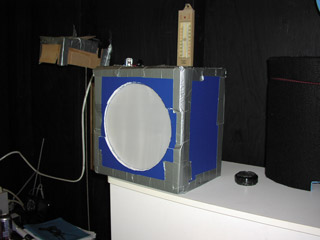
Flat frames correct for the uneven distribution of light across the CCD chip. They also correct for vignetting, dust motes and other obstructions on the optics. I find that flat fields are necessary with my setup at focal lengths shorter than f6.3. I built an Al Kelly type light box (image below) that works perfectly. See Al's site for details on the construction. (http://www.ghg.net/akelly/procccd.htm) As a side note, Al's site is a wonderful source of all information on processing images. This box is extremely light weight and sits on the telescope at any orientation. I think it cost about $5 to build.
When shooting flats, I usually aim for a exposure length that is about 1/3 the well depth of the chip. In the case of the MX7C this is about 30K adu. At f4.2 this is usually about .7 sec with my particular setup. I shoot the flats using hires interlace binning and usually shoot at least 10 flats since it takes no time at all. I set up Astroart to take a sequence which usually takes less than 5 min. I always also shoot the same number of flat darks at the same exposure time. It's important to emphasize that you should shoot the flats without moving the camera or the telescope from the position the images were taken.
To correct the images from the MX7C, you cannot just divide the flat frames into the image. If you do this, the color information in the image will be corrupted. They must first be converted to a luminence type image. In Astroart, I load the flats and flat darks into the "flats" and flat darks portion of the preprocessing menu. Select "keep" and avg or median combine and press "okay". The resulting flat frame actually contains color information which has to be removed before applying it to the raw images. Use the color synthesis plug-in to produce a luminence frame and save this to your folder with your images.
The flat frame can now be applied to the raw images
along with your darks and should correct for any uneven light distribution,
dust motes, and vignetting.
